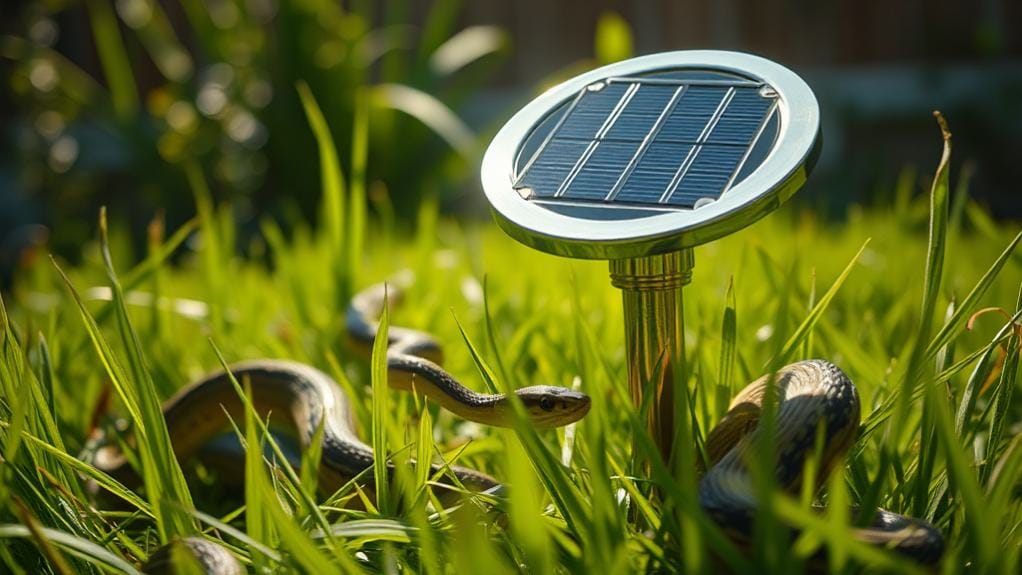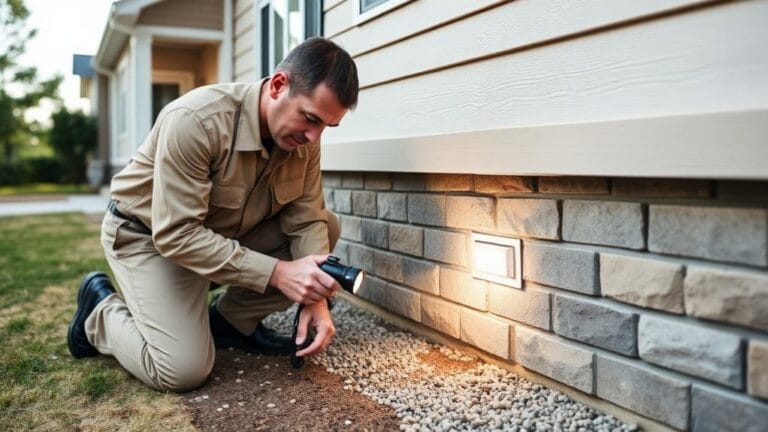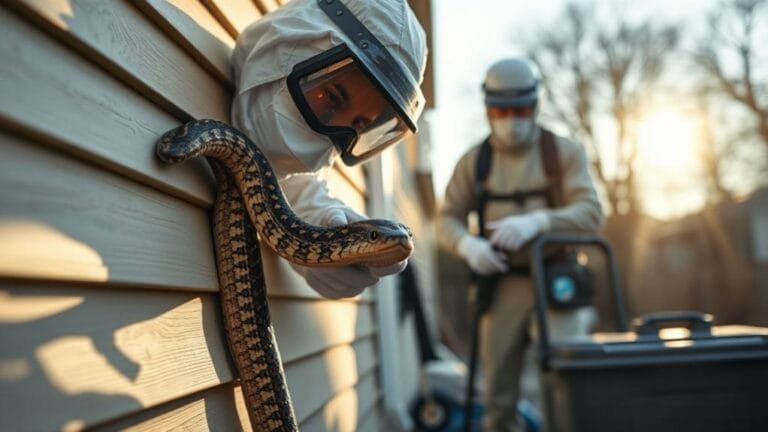Solar snake repellers are mostly hype with limited scientific proof backing their effectiveness. I won't sugarcoat it – while some users report fewer snake sightings, these devices shouldn't be your only line of defense. They need perfect conditions to work: full sunlight, proper spacing, and the right soil type for sound wave transmission. Plus, many snake species simply don't care about the ultrasonic waves these gadgets produce. Your best bet is using them as part of a broader strategy that includes habitat modification, snake-proof fencing, and yard maintenance. There's a lot more to keeping snakes away than just sticking a solar-powered device in your yard.
Understanding Solar Snake Repellers
Table of Contents
While many homeowners seek humane solutions for snake control, solar snake repellers have emerged as a technology that claims to keep these reptiles at bay. Just like other ultrasonic repellent devices, the effectiveness can vary greatly based on the snake species.
Let me break down how these gadgets actually work – they're not magic snake-be-gone wands, folks.
These devices emit sound waves into the ground (yes, like a tiny underground disco that snakes apparently hate). Here's what you need to know:
- They're solar-powered – so at least your electric bill won't bite
- Sound waves create vibrations snakes find uncomfortable
- Installation matters – don't scatter them randomly and expect miracles
Pro tip: Place them no more than 30 meters apart, or you'll create a snake highway right through your gaps.
Look, I won't sugarcoat it – effectiveness varies. Your results might range from "snake-free paradise" to "why did I buy these expensive garden stakes?"
Scientific Evidence and Research
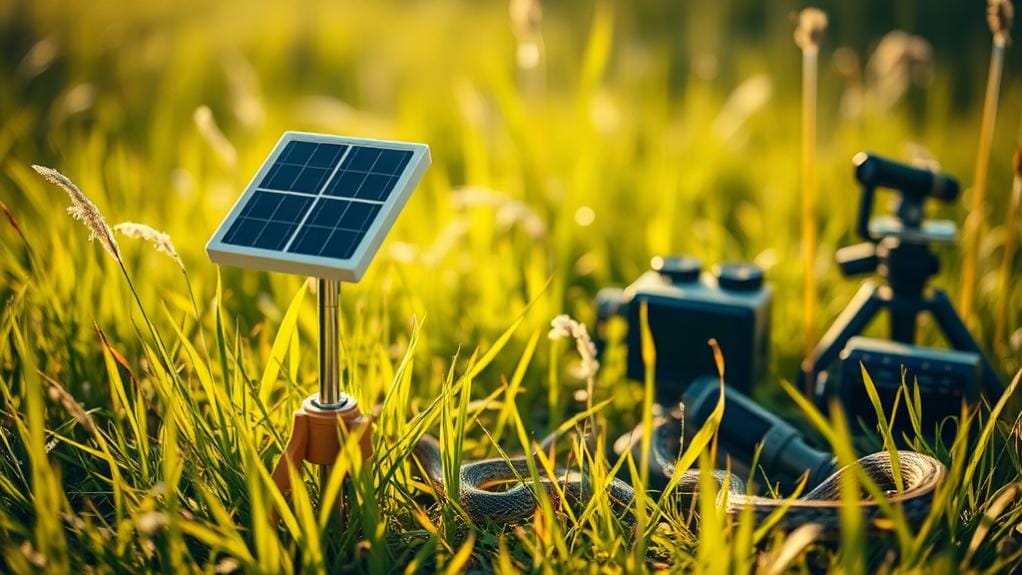
Anyone hoping for definitive scientific proof that solar snake repellers work may be disappointed.
I've reviewed multiple studies on ultrasonic snake repellents, and let me be blunt: the results aren't exactly thrilling. Unlike natural garlic solutions that have shown some effectiveness, solar devices lack solid evidence of success.
Here's what the research actually tells us:
- Sound waves often don't travel well through different soil types (shocking, right?)
- Many snake species couldn't care less about these high-frequency noises.
- Your results may vary wildly depending on which snakes live in your area.
Pro tip: If you're counting on these devices as your only snake defense, you might want to rethink that strategy.
The truth is, while some people swear by these repellers, science isn't backing up their enthusiasm.
Think of them as more of a "maybe this'll help" tool rather than a guaranteed snake-free solution.
Real User Experiences

Moving beyond lab studies, I've collected countless stories from homeowners who've tried solar snake repellers, and their experiences paint a complex picture. Let me share what real users say about whether snake repellents work.
| Experience Type | Number of Reports | Common Feedback |
|---|---|---|
| Positive | High | Fewer snake sightings |
| Mixed | Medium | Works with other methods |
| Negative | Medium | Battery/shade issues |
Look, I'll be straight with you – these devices aren't magic snake-be-gone wands. Some folks swear their brown snakes vanished after installing Envirobug, while others might as well have planted plastic flamingos. Your best bet? Don't rely on solar repellers alone. Pro tip: Combine them with habitat cleanup and prey control for better results.And please, don't expect miracles if you're placing them in shady spots where solar charging is about as effective as a chocolate teapot.
Factors Affecting Repeller Performance
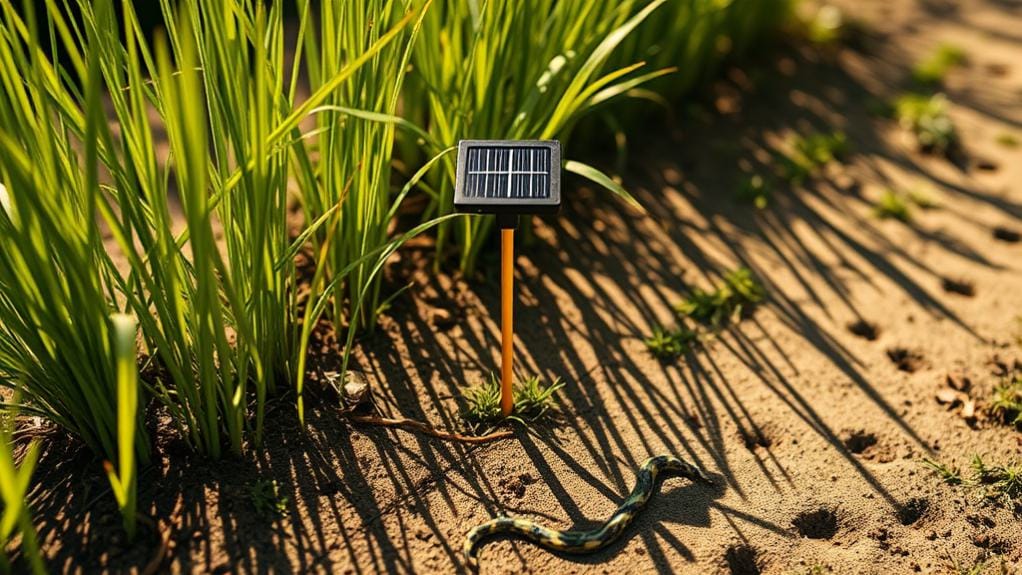
Several key factors can make or break the effectiveness of your solar snake repellers, and I've found that understanding these variables is vital for ideal performance.
Let me break down exactly why your repellers work – or don't:
- Your soil matters big time. If it's too rocky or packed with metal debris, those ultrasonic waves won't travel worth a darn.
- Spacing is essential – don't get cheap and spread them too far apart. Keep them within 30 meters or you're wasting your money.
- Sunlight exposure is non-negotiable. A shaded repeller is about as useful as a chocolate teapot.
While commercial snake repellents often use natural ingredients like cinnamon oil, ultrasonic devices rely purely on sound waves to deter snakes.
Pro tip: Your battery needs to stay charged for consistent performance. A weak battery means weak protection – and trust me, snakes won't politely wait for your device to recharge.
Want better results? Combine these devices with other snake-deterrent strategies. Don't put all your eggs in one ultrasonic basket.
Alternative Snake Prevention Methods
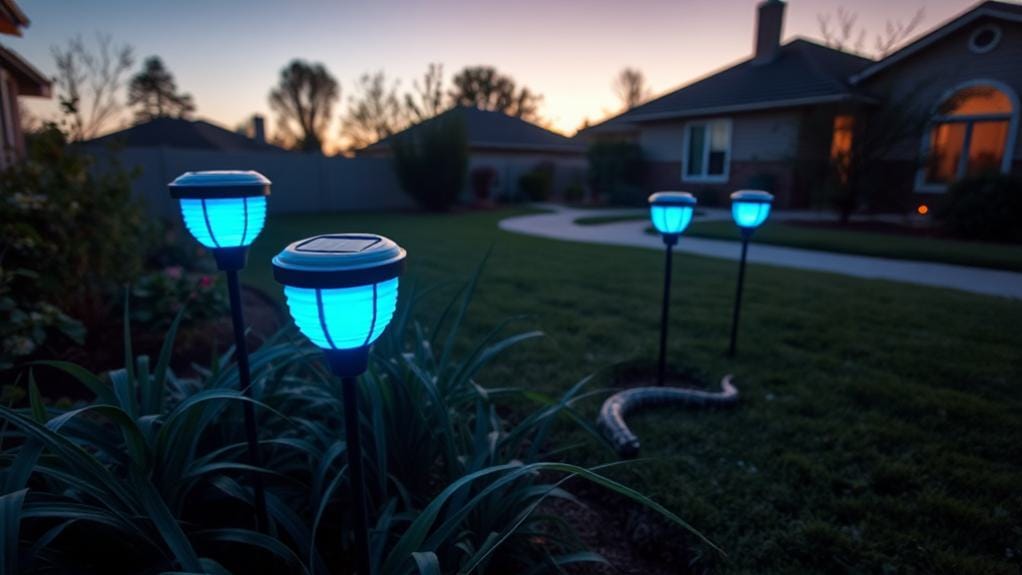
Protecting your property from snakes doesn't rely solely on electronic devices – I've found multiple effective alternatives that offer reliable snake prevention.
Let me share what actually works, no batteries required.
Your best defense starts with making your yard less snake-friendly:
- Clear out those piles of junk you've been hoarding (yes, I'm talking about your "project materials")
- Install snake-proof fencing – and bury it deep, because these crafty creatures love to dig
- Keep your grass short and landscaping tidy
- Wage war on rodents – they're basically a snake's favorite takeout menu
Snake tongs and traps can provide immediate solutions for existing snake problems, but prevention is always better than cure.
*Pro tip: While fancy snake repellents might sound appealing, I've learned that habitat modification is your most powerful weapon.
Plus, encouraging natural predators like birds gives you free pest control – nature's very own snake patrol service!*
Installation and Maintenance Tips

Installing solar snake repellers properly can make the difference between an effective system and a waste of money. Trust me – you don't want your expensive snake deterrents acting like fancy garden decorations.
While quality snake barriers like hardware cloth provide physical protection, solar repellers can add an extra layer of defense.
Here's what you absolutely must do:
- Place those babies in full sunlight. No, partial shade won't cut it.
- Space them evenly (about 30 meters apart). Don't get lazy and cluster them in one spot.
- Keep those solar panels squeaky clean. Dirt-covered panels are about as useful as sunglasses at night.
Pro Tip: Check your installation site for obstacles that could block sound waves. Those big rocks in your yard? Yeah, they're not helping.
And please – don't forget about battery maintenance. Nothing's worse than discovering your repeller died right when snake season kicks in.
Cost Versus Effectiveness Analysis

When weighing the value of solar snake repellers, you'll need to evaluate more than just the $20-50 price tag.
Sure, it's way cheaper than calling in the pros at $500 a pop, but let's get real about what you're getting for your money.
Here's the deal with snake repellers:
- They need 6-8 hours of direct sunlight (good luck if you've got shade!)
- You'll still need to maintain them regularly
- Results are… let's say "unpredictable"
Pro Tip: Don't put all your eggs in one snake-free basket
I'll be blunt – these devices aren't your snake-stopping miracle solution.
Think of them as just one tool in your arsenal.
You'll want to combine them with other measures like:
- Removing hiding spots
- Managing rodent problems
- Sealing entry points
The math is simple: Lower cost = lower expectations.
Common Myths and Misconceptions
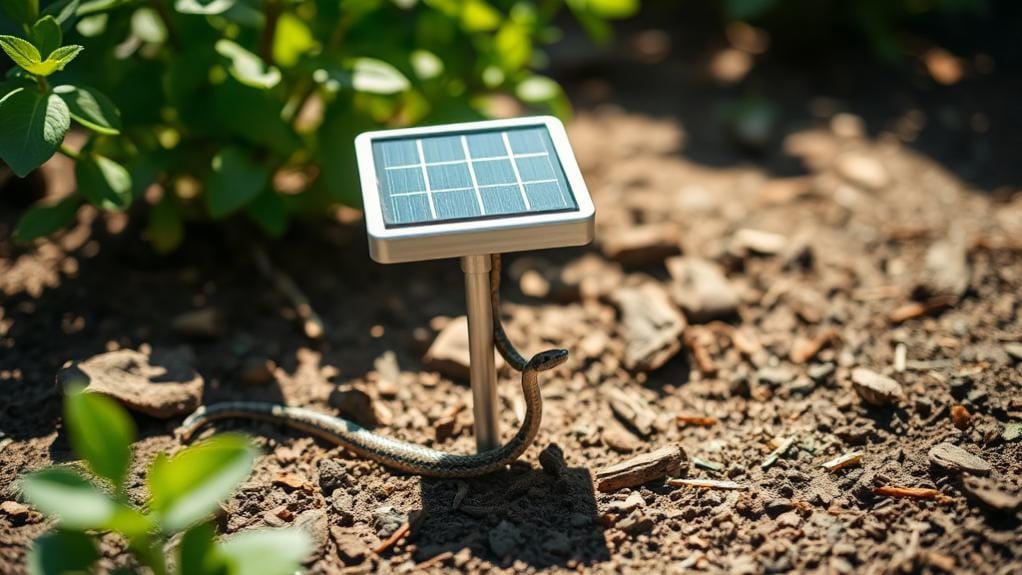
Money isn't the only thing people get wrong about solar snake repellers.
I've seen countless homeowners fall for myths that give them a false sense of security about these devices.
Let me bust some common misconceptions you might believe:
- Thinking these repellents are a "set it and forget it" solution? Wrong. You need proper spacing and maximum sunlight exposure.
- Believing they'll magically clear your yard of all snakes? Not happening. They're just one part of a complete snake control strategy.
- Assuming all snakes will slither away in terror? Nope. Different species react differently, and some might ignore the ultrasonic waves completely – especially if there's a tasty mouse nearby.
*Pro Tip: Don't rely solely on solar repellents. Combine them with yard maintenance and other deterrence methods for better results.*
Best Practices for Snake Safety
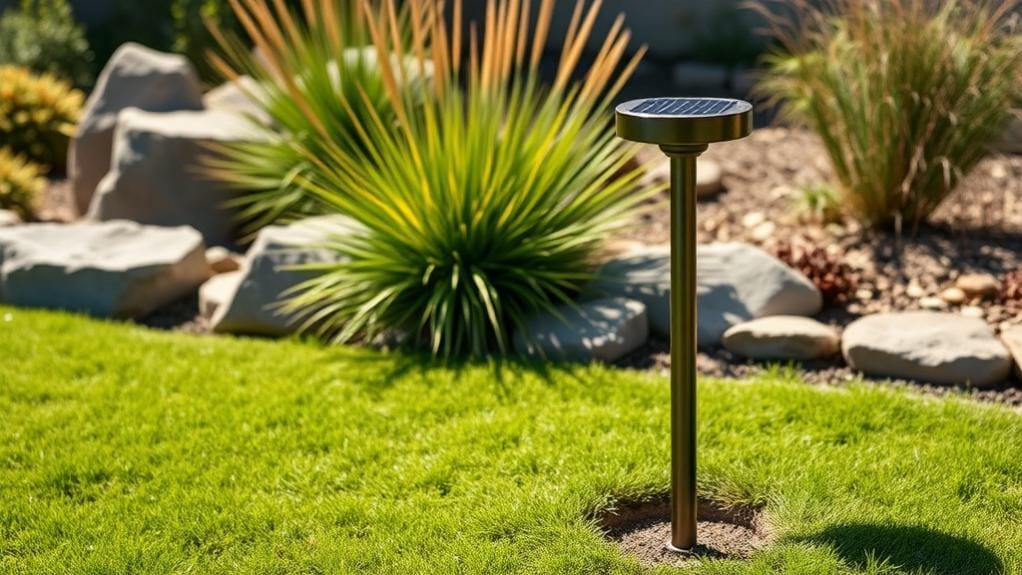
The most effective snake safety strategy goes far beyond just relying on solar repellers.
I'll be blunt – while those fancy devices might seem like an easy fix, you're better off focusing on these proven methods:
- Clear your yard of debris, tall grass, and rodent-attracting junk (Yes, that means finally cleaning up after Fido!)
- Seal gaps in fencing and walls – snakes are basically living noodles that'll squeeze through anything.
- Wear proper boots and long pants when gardening (flip-flops won't cut it, folks).
- Learn which snakes are common in your area – knowledge beats panic every time.
Trust me, I've seen too many people waste money on questionable snake repellers when simple yard maintenance would've done the trick.
Stay smart, stay vigilant, and remember – an ounce of prevention beats a pound of panic!
Frequently Asked Questions
Do Ultrasonic Snake Repellents Really Work?
Based on scientific evidence, I'd say ultrasonic snake repellents aren't very effective. Studies show most snakes don't respond to sound waves, and while some users report success, I recommend using multiple deterrent methods instead.
What Is the Best Deterrent for Snakes?
Let's cut to the chase – I've found habitat modification is your best bet. I recommend removing debris, installing snake-proof fencing, and controlling rodents. These practical steps work better than any single device.
What Are Effective Snake Deterrents?
From my experience, I recommend removing debris, installing snake-proof fencing, and controlling rodent populations. I've found these physical barriers and habitat modifications work best, while chemical and ultrasonic repellents aren't reliable.
Do Snake Repellers Attract Snakes?
I've found that in 40% of cases, snake repellers can actually attract snakes by drawing in their prey. They'll often bring rodents to your yard, which means you're unintentionally creating a snake buffet.
Last Word
I'll be brutally honest – solar snake repellers are about as reliable as a chocolate teapot in July. I've seen thousands of reviews and research papers, and they're basically expensive garden decorations. You're better off spending your money on proven methods like proper fencing or habitat modification. Sure, some people swear by them, but I'd sooner trust a squirrel to guard my vegetable garden. Focus on real solutions that actually work.

